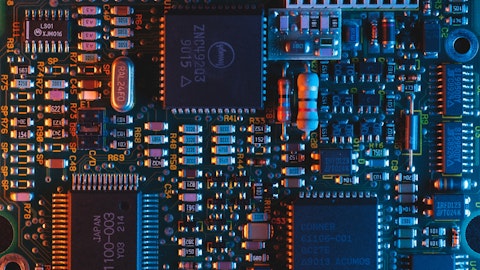Chris Caso: Okay. That’s clear. Thank you. As a follow-up, if you could speak about pricing for the remainder of your products and/or just made it clear that large number, the vast majority of products are sole sourced and knowing that those customers are buying the product for the performance. But as you see some of the more conventional quartz products decline in pricing. Is there a risk that the gap between SiTime’s pricing and the more conventional pricings widened to the point that you do see some pressure? What are your customers telling you and kind of what are you seeing in the market right now?
Rajesh Vashist: Right. The way I see it is that there are some products of SiTime’s that have no comparable product. I would say that significant in comms and enterprise in significant part of auto and clearly in the military aerospace business. That’s also true in some of our other products, but let’s just focus on this one. On this, we see no competition, we see no quest for lower pricing, because our customers clearly understand how unique our products are in providing value. On the products that are pin for pin compatible, higher volume, typically in industrial, perhaps in consumer, maybe in some lower end of networking telecommunications. Even there, recall, Chris, that we still sell at a premium price. That means that even in those markets, we sell in the higher end of that customer’s product, which also means that we don’t see any pricing pressure.
And to the extent we do — we have been able to adjust for it in a particular way that it doesn’t impact us. And continues to lead to growth in our blended pricing, including our largest customer for the last several quarters. So I’m very confident that SiTime is in a good position, primarily because of a highly differentiated products, whether they are in the focus markets or in our non-focus markets.
Chris Caso: Got it. Thank you.
Rajesh Vashist: Yes.
Operator: Thank you. Please standby for our next question. Our next question comes from the line of Alessandra Vecchi with William Blair. Your line is open.
Alessandra Vecchi: Hi, thanks for taking my question. Just some additional color on your largest customer. Should we be thinking about to take that much revenue out for the next two quarters that really look like they’ve been building inventory over the last year plus? Should we be thinking about like normalized rates for that customer more in the kind of 2019, 2020 timeframe? Or do you think they can get back to 2021 levels at some point in the future?
Art Chadwick: Yes. I think they can get back to 2021 levels. Clearly, they overbought or more precisely their subcontractors overbought. But we haven’t lost any sockets there. And they’re a great customer of ours. We work very closely with them. So yes, I think we can get back to those types of numbers.
Rajesh Vashist: I think, Alex, there’s been some decline in their natural demand. It’s probably in the news as well. But in generally — in general, it is they have a very complex, more than anybody else, they have a whole host of CMs. And I think that between the CMs and them, they — it took a while for them to figure it out, but they did. And we look forward to any changed forecasting methods from them. And we’ve had some discussions on that.
Alessandra Vecchi: Perfect. That’s helpful. I was just trying to think about on a more normalized level. And then similarly, not to harp on the consumer segment in general, but we’ve had conversations talking about the non-apple consumer portion being allowed to, sort of, bleed out over time as customers maybe go back to court. But in the fourth quarter, it looks like revenue, sort of, increased sequentially and I believe you said it would be flattish in Q1? Can you add some color on what you’re seeing from customers in terms of their appetite to go back to courts versus stay with you? And how we should think about that over the next year or two?
Rajesh Vashist: Yes. In general, as I said earlier, we see that wherever they have — when our customers have differentiated products, they tend to use SiTime. And so we have found very little, if any, almost de minimis loss of business as a consequence of the increased availability of quartz crystal. So we think that ex our largest customer as well, that our business with consumer continues quite solidly. And in fact, we continue to get some nice design wins that will help us in the second half of the year, I believe.
Art Chadwick: And Alex, I’ll just add another comment to that. We have talked about that segment declining over time, but not going to zero. There are still as Rajesh mentioned, customers in the consumer space where we provide real value. So we’re not expecting those numbers to go to zero. And as I mentioned in my script, it was $9.2 million in fourth quarter, that was up what $1 million maybe a $1.5 million from Q3. So I mean that’s I think a reasonable run rate for us there. And over time, if we have the right customers that could even go up.
Alessandra Vecchi: Great. That’s very helpful. Thank you.
Operator: Thank you. Please standby for our next question. Our next question comes from the line of Suji Desilva with ROTH. Your line is open.
Suji Desilva: Hi, Rajesh. Hi, Art. Appreciate, Art the gross margin guidance towards the end of the year and the confidence there. I want to understand if that — I imagine imply steady pricing is an assumption or if there’s improved blended pricing has been that assumption to going back to mid-60s from end market or product mix uplifts?
Art Chadwick: Well, I mean, one of our basic themes and one of the ways that we got our gross margins to expand from the high-40s three years ago when we went public to 65% for the full-year that we just finished. Is that most of our new products are focused on the market segments that Rajesh mentioned, which are generally higher performance markets, we get higher ASPs and higher gross margins. So over time, as those new products become a larger percentage of our sales, that will continue to help expand our gross margins. And I think we’ll see some of that certainly in the back half of this year and going out for a number of years.
Rajesh Vashist: That’s right. And the confidence, I think some of the metrics that we gave Suji are all related. Our ASP’s solidity and growth is related to a single source. It’s related to our new products and it’s related to our SAM expansion. They’re all four tied together, which is why it’s all part of one strategy. Deliver highly differentiated products that customers just got to have. And I think, of course, we see the benefit of that in the relatively short-term in the coming quarters. But the real benefit for that is going to come in growth and stickiness in 2024 and 2025 and so on. So I think as those products, we talked about nine products as they unfold, in the marketplace as we get the design wins, I think it will be really good.
Suji Desilva: Okay, great. And then my follow-up question is those new products as they’re coming in and winning. I presume they’re more focused on the non-consumer markets, auto, infrastructure data center. What’s the design cycle there and those programs to ramp? And is there sort of an elbow point when these new products were announced some of them late in €˜22 that we start to see them come in through design win ramps?
Rajesh Vashist: Yes. So it’s — the typical thing would be to say that in the comms enterprise, automotive, aerospace defense, a rule of thumb would be about 18-months to ramp to revenue. That being said, we actually see sometimes enough of a desire for our products that they get rushed to markets quicker than we or ever thought. Also don’t forget that while seven out of nine of these products are in fact meant for these focus segments, the remaining two are in fact for consumer, IoT and mobile. And those balance it out by a shorter design win, let’s say, less than a year and shorter time to revenue less than a year. And so to get to its full glory, I think it takes maybe three years for a product in the focus areas. But again, a reminder that none of our products have ever been obsolete from the time we introduced them 12-years ago, 13-years ago, So they still continue to sell. So that’s an important way of understanding the value.
Suji Desilva: Very helpful, Rajesh. Thanks guys.
Rajesh Vashist: Yes. And again, these new products, this looks forward, but we also introduced a lot of products last year and in 2021 and going back to 2020. So even though some of these design cycles can be one, two or three years, we have a number of products that are in the middle of those design cycles, yes.
Suji Desilva: Okay, great. Sounds good. Thanks guys.
Operator: Thank you. Our next question comes from the line of Tore Svanberg with Stifel. Your line is open.
Tore Svanberg: Yes. Thank you, Rajesh. Thank you, Art. I had a question about your largest customer. Especially as far as then moving manufacturing around. I mean, I think this is sort of in the public domain too. And I’m just wondering if some of this inventory build and subsequent reduction, has anything to the diversification of the manufacturing base or do you think this is just more purely the front of manufacturers building tumor supply when supply were short?
Rajesh Vashist: Yes, it’s a tricky question to ask and there are some things we don’t want to talk about too much. But I think they do have more CMs than anybody else, that’s point one. The second point is that we understand that in tough times, all CMs, many CMs over order for a variety of reasons. Some good ones, some not so good ones. In the case of our largest, historically largest customer, we have spent a lot of time in the past years looking at forecast directly from them and comparing it to forecast from the CMs. You can almost say that in some ways, we were somewhat instrumental in helping all parties understand what the real situation was. So SiTime has been a value-add player in all of this.
Tore Svanberg: Yes, that’s great perspective, Rajesh. And as my follow-up, your inventories. So again, given that your — the sales to your largest customer is going to be basically nominal next two quarters. Can you just give us some confidence in that $58 million in inventory? You mentioned most of it should be in wafer or in raw materials? So again, just wondering how we should think about that $58 million given the big drop off this in the first half of the year?





